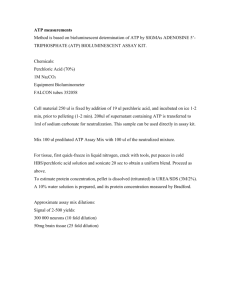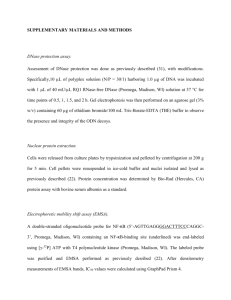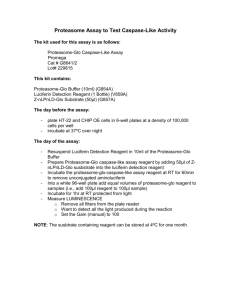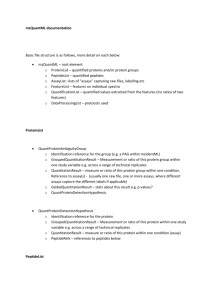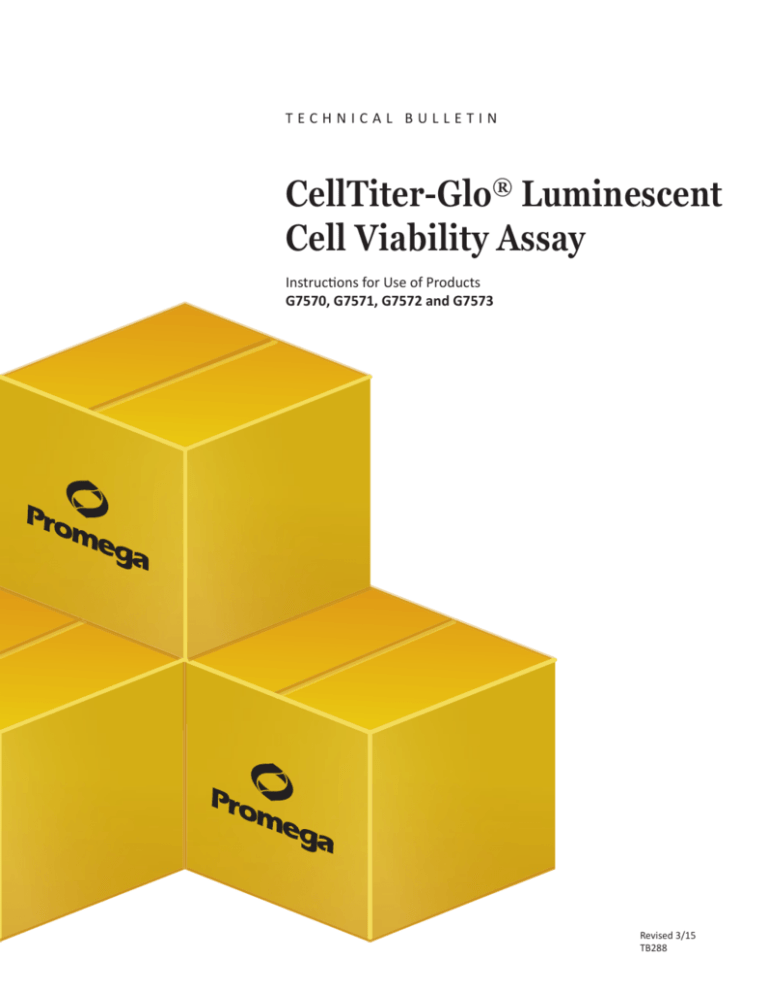
TECHNICAL BULLETIN
CellTiter-Glo® Luminescent
Cell Viability Assay
Instructions for Use of Products
G7570, G7571, G7572 and G7573
Revised 3/15
TB288
CellTiter-Glo® Luminescent
Cell Viability Assay
All technical literature is available at: www.promega.com/protocols/
Visit the web site to verify that you are using the most current version of this Technical Bulletin.
E-mail Promega Technical Services if you have questions on use of this system: techserv@promega.com
1. Description.......................................................................................................................................... 1
2. Product Components and Storage Conditions......................................................................................... 5
3. Performing the CellTiter-Glo® Assay...................................................................................................... 6
3.A. Reagent Preparation.................................................................................................................... 6
3.B. Protocol for the Cell Viability Assay............................................................................................... 6
3.C. Protocol for Generating an ATP Standard Curve (optional)............................................................. 7
4. Appendix............................................................................................................................................. 8
4.A. Overview of the CellTiter-Glo® Assay............................................................................................ 8
4.B. Additional Considerations............................................................................................................ 9
4.C.References................................................................................................................................ 11
4.D. Related Products....................................................................................................................... 12
5. Summary of Change........................................................................................................................... 14
1.Description
The CellTiter-Glo® Luminescent Cell Viability Assay(a–d) is a homogeneous method to determine the number of viable
cells in culture based on quantitation of the ATP present, which signals the presence of metabolically active cells. The
CellTiter-Glo® Assay is designed for use with multiwell-plate formats, making it ideal for automated high-throughput
screening (HTS) and cell proliferation and cytotoxicity assays. The homogeneous assay procedure (Figure 1) involves
adding a single reagent (CellTiter-Glo® Reagent) directly to cells cultured in serum-supplemented medium. Cell
washing, removal of medium or multiple pipetting steps are not required.
The homogeneous “add-mix-measure” format results in cell lysis and generation of a luminescent signal proportional
to the amount of ATP present (Figure 2). The amount of ATP is directly proportional to the number of cells present in
culture in agreement with previous reports (1). The CellTiter-Glo® Assay relies on the properties of a proprietary
thermostable luciferase (Ultra-Glo™ Recombinant Luciferase), which generates a stable “glow-type” luminescent
signal and improves performance across a wide range of assay conditions. The luciferase reaction for this assay is
shown in Figure 3. The half-life of the luminescent signal resulting from this reaction is greater than five hours
(Figure 4). This extended half-life eliminates the need for reagent injectors and provides flexibility for continuous or
batch-mode processing of multiple plates. The unique homogeneous format reduces pipetting errors that may be
introduced during the multiple steps required by other ATP-measurement methods.
Promega Corporation · 2800 Woods Hollow Road · Madison, WI 53711-5399 USA · Toll Free in USA 800-356-9526 · 608-274-4330 · Fax 608-277-2516
www.promega.com TB288 · Revised 3/15
1
1.
Description (continued)
CellTiter-Glo®
Substrate
CellTiter-Glo®
Buffer
CellTiter-Glo®
Reagent
Luminometer
3170MA12_0A
Mix
Figure 1. Flow diagram showing preparation and use of CellTiter-Glo® Reagent.
2
Promega Corporation · 2800 Woods Hollow Road · Madison, WI 53711-5399 USA · Toll Free in USA 800-356-9526 · 608-274-4330 · Fax 608-277-2516
TB288 · Revised 3/15
www.promega.com
System Advantages
•
Homogeneous: “Add-mix-measure” format reduces the number of plate-handling steps to fewer than that
required for similar ATP assays.
•
Fast: Data can be recorded 10 minutes after adding reagent.
•
Sensitive: Measures cells at numbers below the detection limits of standard colorimetric and fluorometric assays.
•
Flexible: Can be used with various multiwell formats. Data can be recorded by luminometer or CCD camera or
imaging device.
•
Robust: Luminescent signal is very stable, with a half-life >5 hours, depending on cell type and culture medium
used.
•
Able to Multiplex: Can be used with reporter gene assays or other cell-based assays from Promega (2,3).
3.5 × 106
r² = 0.99
R² = 0.999
3.0 × 106
2.5 × 106
2.0 × 106
50,000
1.5 × 106
30,000
40,000
1.0 × 106
20,000
0.5 × 106
0
0
r² = 0.99
10,000
0
10,000
20,000
30,000
Cells per Well
0
100
40,000
200
300
50,000
400
60,000
3171MA12_0A
Luminescence (RLU)
4.0 × 106
Figure 2. Cell number correlates with luminescent output. A direct relationship exists between luminescence
measured with the CellTiter-Glo® Assay and the number of cells in culture over three orders of magnitude. Serial
twofold dilutions of HEK293 cells were made in a 96-well plate in DMEM with 10% FBS, and assays were performed
as described in Section 3.B. Luminescence was recorded 10 minutes after reagent addition using a GloMax®-Multi+
Detection System. Values represent the mean ± S.D. of four replicates for each cell number. The luminescent signal
from 50 HEK293 cells is greater than three times the background signal from serum-supplemented medium without
cells. There is a linear relationship (r2 = 0.99) between the luminescent signal and the number of cells from 0 to 50,000
cells per well.
Promega Corporation · 2800 Woods Hollow Road · Madison, WI 53711-5399 USA · Toll Free in USA 800-356-9526 · 608-274-4330 · Fax 608-277-2516
www.promega.com TB288 · Revised 3/15
3
Description (continued)
HO
S
N
N
S
COOH
Ultra-Glo™ Recombinant
Luciferase
+ATP+O2
Mg2+
Beetle Luciferin
O
S
N
N
S
O
+AMP+PPi+CO2+Light
Oxyluciferin
1399MD03_6A
1.
100
90
80
70
60
50
40
30
20
10
0
CHO-K1
BHK-21
HepG2
0
50
100 150 200 250 300
Time (minutes)
3173MA12_0A
Relative Luminescence (%)
Figure 3. The luciferase reaction. Mono-oxygenation of luciferin is catalyzed by luciferase in the presence of Mg2+,
ATP and molecular oxygen.
Figure 4. Extended luminescent half-life allows high-throughput batch processing. Signal stability is shown
for three common cell lines. HepG2 and BHK-21 cells were grown and assayed in MEM containing 10% FBS, while
CHO-K1 cells were grown and assayed in DME/F-12 containing 10% FBS. CHO-K1, BHK-21 and HepG2 cells, at
25,000 cells per well, were added to a 96-well plate. After an equal volume of CellTiter-Glo® Reagent was added, plates
were shaken and luminescence monitored over time with the plates held at 22°C. The half-lives of the luminescent
signals for the CHO-K1, BHK-21 and HepG2 cells were approximately 5.4, 5.2 and 5.8 hours, respectively.
4
Promega Corporation · 2800 Woods Hollow Road · Madison, WI 53711-5399 USA · Toll Free in USA 800-356-9526 · 608-274-4330 · Fax 608-277-2516
TB288 · Revised 3/15
www.promega.com
2.
Product Components and Storage Conditions
PRODUCT
S I Z E C A T. #
CellTiter-Glo® Luminescent Cell Viability Assay
10ml
G7570
Substrate is sufficient for 100 assays at 100µl/assay in 96-well plates or 400 assays at 25µl/assay in 384-well
plates. Includes:
•
•
1 × 10ml CellTiter-Glo® Buffer
1 vial CellTiter-Glo® Substrate (lyophilized)
PRODUCT
CellTiter-Glo® Luminescent Cell Viability Assay
S I Z E C A T. #
10 × 10ml
G7571
Each vial of substrate is sufficient for 100 assays at 100µl/assay in 96-well plates or 400 assays at 25µl/assay
in 384-well plates (1,000 to 4,000 total assays). Includes:
• 10 × 10ml CellTiter-Glo® Buffer
•
10 vials CellTiter-Glo® Substrate (lyophilized)
PRODUCT
CellTiter-Glo® Luminescent Cell Viability Assay
S I Z E C A T. #
100ml
G7572
Substrate is sufficient for 1,000 assays at 100µl/assay in 96-well plates or 4,000 assays at 25µl/assay in
384-well plates. Includes:
• 1 × 100ml CellTiter-Glo® Buffer
•
1 vial CellTiter-Glo® Substrate (lyophilized)
PRODUCT
CellTiter-Glo® Luminescent Cell Viability Assay
S I Z E C A T. #
10 × 100ml
G7573
Each vial of substrate is sufficient for 1,000 assays at 100µl/assay in 96-well plates or 4,000 assays at
25µl/assay in 384-well plates (10,000 to 40,000 total assays). Includes:
• 10 × 100ml CellTiter-Glo® Buffer
•
10 vials CellTiter-Glo® Substrate (lyophilized)
Storage Conditions: For long-term storage, store the lyophilized CellTiter-Glo® Substrate and CellTiter-Glo® Buffer
at –20°C. For frequent use, the CellTiter-Glo® Buffer can be stored at 4°C or room temperature for 48 hours without
loss of activity. See product label for expiration date information. Reconstituted CellTiter-Glo® Reagent (Buffer plus
Substrate) can be stored at room temperature for up to 8 hours with <10% loss of activity, at 4°C for 48 hours with
~5% loss of activity, at 4°C for 4 days with ~20% loss of activity or at –20°C for 21 weeks with ~3% loss of activity.
The reagent is stable for up to ten freeze-thaw cycles, with less than 10% loss of activity.
Promega Corporation · 2800 Woods Hollow Road · Madison, WI 53711-5399 USA · Toll Free in USA 800-356-9526 · 608-274-4330 · Fax 608-277-2516
www.promega.com TB288 · Revised 3/15
5
3.
Performing the CellTiter-Glo® Assay
Materials to Be Supplied by the User
•
opaque-walled multiwell plates adequate for cell culture
•
multichannel pipette or automated pipetting station for reagent delivery
•
•
•
device (plate shaker) for mixing multiwell plates
luminometer, CCD camera or imaging device capable of reading multiwell plates
optional: ATP for use in generating a standard curve (Section 3.C)
3.A. Reagent Preparation
1.
Thaw the CellTiter-Glo® Buffer, and equilibrate to room temperature prior to use. For convenience the
CellTiter-Glo® Buffer may be thawed and stored at room temperature for up to 48 hours prior to use.
2.
Equilibrate the lyophilized CellTiter-Glo® Substrate to room temperature prior to use.
3.
Transfer the appropriate volume (10ml for Cat.# G7570 and G7571, or 100ml for Cat.# G7572 and G7573) of
CellTiter-Glo® Buffer into the amber bottle containing CellTiter-Glo® Substrate to reconstitute the lyophilized
enzyme/substrate mixture. This forms the CellTiter-Glo® Reagent.
4.
Mix by gently vortexing, swirling or inverting the contents to obtain a homogeneous solution. The CellTiter-Glo®
Substrate should go into solution easily in less than 1 minute.
3.B. Protocol for the Cell Viability Assay
We recommend that you perform a titration of your particular cells to determine the optimal number and ensure that
you are working within the linear range of the CellTiter-Glo® Assay. Figure 2 provides an example of such a titration of
HEK293 cells using 0 to 50,000 cells per well in a 96-well format.
1.
!
Prepare opaque-walled multiwell plates with mammalian cells in culture medium, 100µl per well for 96-well
plates or 25µl per well for 384-well plates.
Multiwell plates must be compatible with the luminometer used.
2.
Prepare control wells containing medium without cells to obtain a value for background luminescence.
3.
Add the test compound to experimental wells, and incubate according to culture protocol.
4.
Equilibrate the plate and its contents at room temperature for approximately 30 minutes.
6
Promega Corporation · 2800 Woods Hollow Road · Madison, WI 53711-5399 USA · Toll Free in USA 800-356-9526 · 608-274-4330 · Fax 608-277-2516
TB288 · Revised 3/15
www.promega.com
5.
Add a volume of CellTiter-Glo® Reagent equal to the volume of cell culture medium present in each well (e.g.,
add 100µl of reagent to 100µl of medium containing cells for a 96-well plate, or add 25µl of reagent to 25µl of
medium containing cells for a 384-well plate).
6.
Mix contents for 2 minutes on an orbital shaker to induce cell lysis.
7.
Allow the plate to incubate at room temperature for 10 minutes to stabilize luminescent signal.
Note: Uneven luminescent signal within standard plates can be caused by temperature gradients, uneven
seeding of cells or edge effects in multiwell plates.
8.
Record luminescence.
Note: Instrument settings depend on the manufacturer. An integration time of 0.25–1 second per well should
serve as a guideline.
3.C. Protocol for Generating an ATP Standard Curve (optional)
It is a good practice to generate a standard curve using the same plate on which samples are assayed. We recommend
ATP disodium salt (Cat.# P1132, Sigma Cat.# A7699 or GE Healthcare Cat.# 27-1006). The ATP standard curve
should be generated immediately prior to adding the CellTiter-Glo® Reagent because endogenous ATPase enzymes
found in sera may reduce ATP levels.
1.
Prepare 1µM ATP in culture medium (100µl of 1µM ATP solution contains 10–10 moles ATP).
2.
Prepare serial tenfold dilutions of ATP in culture medium (1µM to 10nM; 100µl contains 10–10 to 10–12 moles
of ATP).
3.
Prepare a multiwell plate with varying concentrations of ATP standard in 100µl medium
(25µl for a 384-well plate).
4.
Add a volume of CellTiter-Glo® Reagent equal to the volume of ATP standard present in each well.
5.
Mix contents for 2 minutes on an orbital shaker.
6.
Allow the plate to incubate at room temperature for 10 minutes to stabilize the luminescent signal.
7.
Record luminescence.
Promega Corporation · 2800 Woods Hollow Road · Madison, WI 53711-5399 USA · Toll Free in USA 800-356-9526 · 608-274-4330 · Fax 608-277-2516
www.promega.com TB288 · Revised 3/15
7
4.Appendix
4.A. Overview of the CellTiter-Glo® Assay
The assay system uses the properties of a proprietary thermostable luciferase to enable reaction conditions that
generate a stable “glow-type” luminescent signal while simultaneously inhibiting endogenous enzymes released during
cell lysis (e.g., ATPases). Release of ATPases will interfere with accurate ATP measurement. Historically, firefly
luciferase purified from Photinus pyralis (LucPpy) has been used in reagents for ATP assays (1,4–7). However, it
has only moderate stability in vitro and is sensitive to its chemical environment, including factors such as pH and
detergents, limiting its usefulness for developing a robust homogeneous ATP assay. Promega has successfully
developed a stable form of luciferase based on the gene from another firefly, Photuris pennsylvanica (LucPpe2), using
an approach to select characteristics that improve performance in ATP assays. The unique characteristics of this mutant
(LucPpe2m) enabled design of a homogeneous single-reagent-addition approach to perform ATP assays with cultured
cells. Properties of the CellTiter-Glo® Reagent overcome the problems caused by factors, such as ATPases, that
interfere with ATP measurement in cell extracts. The reagent is physically robust and provides a sensitive and stable
luminescent output.
Sensitivity and Linearity: The ATP-based detection of cells is more sensitive than other methods (8–10). In
experiments performed by Promega scientists, the luminescent signal from 50 HEK293 cells is greater than three
standard deviations above the background signal from serum-supplemented medium without cells. There is a linear
relationship (r2 = 0.99) between the luminescent signal and the number of cells from 0 to 50,000 cells per well in the
96-well format. The luminescence values in Figure 2 were recorded after 10 minutes of incubation at room temperature
to stabilize the luminescent signal as described in Section 3.B. Incubation of the same 96-well plate used in the
experiment shown in Figure 2 for 360 minutes at room temperature had little effect on the relationship between
luminescent signal and number of cells (r2 = 0.99).
Speed: The homogeneous procedure to measure ATP using the CellTiter-Glo® Assay is quicker than other ATP assay
methods that require multiple steps to extract ATP and measure luminescence. The CellTiter-Glo® Assay also is faster
than other commonly used methods to measure the number of viable cells (such as MTT, alamarBlue® or Calcein-AM)
that require prolonged incubation steps to enable the cells’ metabolic machinery to convert indicator molecules into a
detectable signal.
8
Promega Corporation · 2800 Woods Hollow Road · Madison, WI 53711-5399 USA · Toll Free in USA 800-356-9526 · 608-274-4330 · Fax 608-277-2516
TB288 · Revised 3/15
www.promega.com
4.B. Additional Considerations
Temperature: The intensity and decay rate of the luminescent signal from the CellTiter-Glo® Assay depends on the
luciferase reaction rate. Environmental factors that affect the luciferase reaction rate will change the intensity and
stability of the luminescent signal. Temperature is one factor that affects the rate of this enzymatic assay and thus the
light output. For consistent results, equilibrate assay plates to a constant temperature before performing the assay.
Transferring eukaryotic cells from 37°C to room temperature has little effect on ATP content (5). We have demonstrated that removing cultured cells from a 37°C incubator and allowing them to equilibrate to 22°C for 1–2 hours had
little effect on ATP content. For batch-mode processing of multiple assay plates, take precautions to ensure complete
temperature equilibration. Plates removed from a 37°C incubator and placed in tall stacks at room temperature will
require longer equilibration than plates arranged in a single layer. Insufficient equilibration may result in a temperature
gradient effect between wells in the center and at the edge of the plates. The temperature gradient pattern also may
depend on the position of the plate in the stack.
Chemicals: The chemical environment of the luciferase reaction affects the enzymatic rate and thus luminescence
intensity. Differences in luminescence intensity have been observed using different types of culture media and sera. The
presence of phenol red in culture medium should have little impact on luminescence output. Assaying 0.1µM ATP in
RPMI medium without phenol red resulted in ~5% increase in luminescence output (in relative light units [RLU])
compared to assays in RPMI containing the standard concentration of phenol red, whereas assays in RPMI medium
containing twice the normal concentration of phenol red showed a ~2% decrease in luminescence.
Solvents for the various test compounds may interfere with the luciferase reaction and thus the light output from the
assay. Interference with the luciferase reaction can be detected by assaying a parallel set of control wells containing
medium without cells. Dimethylsulfoxide (DMSO), commonly used as a vehicle to solubilize organic chemicals, has
been tested at final concentrations of up to 2% in the assay and only minimally affects light output.
Plate Recommendations: We recommend using standard opaque-walled multiwell plates suitable for luminescence
measurements. Opaque-walled plates with clear bottoms to allow microscopic visualization of cells also may be used;
however, these plates will have diminished signal intensity and greater cross talk between wells. Opaque white tape
may be used to decrease luminescence loss and cross talk.
Cellular ATP Content: Different cell types have different amounts of ATP, and values reported for the ATP level in
cells vary considerably (1,4,11–13). Factors that affect the ATP content of cells may affect the relationship between cell
number and luminescence. Anchorage-dependent cells that undergo contact inhibition at high densities may show a
change in ATP content per cell at high densities, resulting in a nonlinear relationship between cell number and
luminescence. Factors that affect the cytoplasmic volume or physiology of cells also will affect ATP content. For
example, oxygen depletion is one factor known to cause a rapid decrease in ATP (1).
Mixing: Optimal assay performance is achieved when the CellTiter-Glo® Reagent is mixed completely with the
cultured cells. Suspension cell lines (e.g., Jurkat cells) generally require less mixing to achieve lysis and extract ATP
than adherent cells (e.g., L929 cells). Tests were done to evaluate the effect of shaking the plate after adding the
CellTiter-Glo® Reagent. Suspension cells cultured in multiwell plates showed only minor differences in light output
whether or not the plates were shaken after adding the CellTiter-Glo® Reagent. Adherent cells are more difficult to lyse
and show a substantial difference between shaken and nonshaken plates.
Promega Corporation · 2800 Woods Hollow Road · Madison, WI 53711-5399 USA · Toll Free in USA 800-356-9526 · 608-274-4330 · Fax 608-277-2516
www.promega.com TB288 · Revised 3/15
9
4.B. Additional Considerations (continued)
Several additional parameters related to reagent mixing include the force of delivery of CellTiter-Glo® Reagent, sample
volume and dimensions of the well. All of these factors may affect assay performance. The degree of reagent mixing
required may be affected by the method used to add the CellTiter-Glo® Reagent to the assay plates. Automated
pipetting devices using a greater or lesser force of fluid delivery may affect the degree of subsequent mixing required.
Complete reagent mixing in 96-well plates should be achieved using orbital plate shaking devices built into many
luminometers and the recommended 2-minute shaking time. Special electromagnetic shaking devices that use a radius
smaller than the well diameter may be required to efficiently mix contents of 384-well plates. The depth of medium and
geometry of the multiwell plates may have an effect on mixing efficiency. We recommend that you take these factors
into consideration when performing the assay and empirically determine whether a mixing step is necessary for the
individual application.
Luminometers
For highly sensitive luminometric assays, the luminometer model and settings greatly affect the quality of data
obtained. Luminometers from different manufacturers will vary in sensitivities and dynamic ranges. We recommend
the GloMax® products because these instruments do not require gain adjustments to achieve optimal sensitivity and
dynamic range. Additionally, GloMax® instruments are preloaded with Promega protocols for ease of use.
If you are not using a GloMax® luminometer, consult the operating manual for your luminometer to determine the
optimal settings. The limits should be verified on each instrument before analysis of experimental samples. The assay
should be linear in some portion of the detection range of the instrument used. For an individual luminometer there
may be different gain settings. We recommend that you optimize the gain settings.
10
Promega Corporation · 2800 Woods Hollow Road · Madison, WI 53711-5399 USA · Toll Free in USA 800-356-9526 · 608-274-4330 · Fax 608-277-2516
TB288 · Revised 3/15
www.promega.com
4.C.References
1.
Crouch, S.P. et al. (1993) The use of ATP bioluminescence as a measure of cell proliferation and cytotoxicity.
J. Immunol. Methods 160, 81–8.
2.
Farfan, A. et al. (2004) Multiplexing homogeneous cell-based assays. Cell Notes 10, 2–5.
3.
Riss, T., Moravec, R. and Niles, A. (2005) Selecting cell-based assays for drug discovery screening. Cell Notes
13, 16–21.
4.
Kangas, L., Grönroos, M. and Nieminen, A.L. (1984) Bioluminescence of cellular ATP: A new method for
evaluating cytotoxic agents in vitro. Med. Biol. 62, 338–43.
5.
Lundin, A. et al. (1986) Estimation of biomass in growing cell lines by adenosine triphosphate assay. Methods
Enzymol. 133, 27–42.
6.
Sevin, B.U. et al. (1988) Application of an ATP-bioluminescence assay in human tumor chemosensitivity testing.
Gynecol. Oncol. 31, 191–204.
7.
Gerhardt, R.T. et al. (1991) Characterization of in vitro chemosensitivity of perioperative human ovarian
malignancies by adenosine triphosphate chemosensitivity assay. Am. J. Obstet. Gynecol. 165, 245–55.
8.
Petty, R.D. et al. (1995) Comparison of MTT and ATP-based assays for the measurement of viable cell number.
J. Biolumin. Chemilumin. 10, 29–34.
9.
Cree, I.A. et al. (1995) Methotrexate chemosensitivity by ATP luminescence in human leukemia cell lines and in
breast cancer primary cultures: Comparison of the TCA-100 assay with a clonogenic assay. AntiCancer Drugs 6,
398–404.
10. Maehara, Y. et al. (1987) The ATP assay is more sensitive than the succinate dehydrogenase inhibition test for
predicting cell viability. Eur. J. Cancer Clin. Oncol. 23, 273–6.
11. Stanley, P.E. (1986) Extraction of adenosine triphosphate from microbial and somatic cells. Methods Enzymol.
133, 14–22.
12. Beckers, B. et al. (1986) Application of intracellular ATP determination in lymphocytes for HLA-typing.
J. Biolumin. Chemilumin. 1, 47–51.
13. Andreotti, P.E. et al. (1995) Chemosensitivity testing of human tumors using a microplate adenosine
triphosphate luminescence assay: Clinical correlation for cisplatin resistance of ovarian carcinoma. Cancer Res.
55, 5276–82.
Promega Corporation · 2800 Woods Hollow Road · Madison, WI 53711-5399 USA · Toll Free in USA 800-356-9526 · 608-274-4330 · Fax 608-277-2516
www.promega.com TB288 · Revised 3/15
11
4.D. Related Products
Cell Proliferation Products
Product
SizeCat.#
ApoLive-Glo™ Multiplex Assay
10ml
G6410
ApoTox-Glo™ Triplex Assay
10ml
G6320
CellTiter-Fluor™ Cell Viability Assay (fluorescent)
10ml
G6080
CellTiter-Blue® Cell Viability Assay (resazurin)
CellTiter 96® AQueous One Solution Cell Proliferation Assay (MTS, colorimetric)
CellTiter 96® AQueous Non-Radioactive Cell Proliferation Assay (MTS, colorimetric)
CellTiter 96® AQueous MTS Reagent Powder
CellTiter 96 Non-Radioactive Cell Proliferation Assay (MTT, colorimetric)
®
20ml
G8080
200 assays
G3582
1,000 assays
G5421
1g
G1111
1,000 assays
G4000
Additional sizes available.
Cytotoxicity Assays
Product
SizeCat.#
CytoTox-Glo™ Cytotoxicity Assay (luminescent)*
10ml
G9290
Mitochondrial ToxGlo™ Assay*
10ml
G8000
MultiTox-Glo Multiplex Cytotoxicity Assay (luminescent, fluorescent)*
10ml
G9270
MultiTox-Fluor Multiplex Cytotoxicity Assay (fluorescent)*
10ml
G9200
CytoTox-Fluor™ Cytotoxicity Assay (fluorescent)*
10ml
G9260
200–800 assays
G7890
1,000–4,000 assays
G7892
1,000 assays
G1780
GSH-Glo™ Glutathione Assay
10ml
V6911
50mlV6912
GSH/GSSG-Glo™ Assay
10ml
50mlV6612
CytoTox-ONE™ Homogeneous Membrane Integrity Assay (LDH, fluorometric)*
CytoTox-ONE™ Homogeneous Membrane Integrity Assay, HTP
CytoTox 96® Non-Radioactive Cytotoxicity Assay (LDH, colorimetric)*
V6611
*Additional sizes available.
12
Promega Corporation · 2800 Woods Hollow Road · Madison, WI 53711-5399 USA · Toll Free in USA 800-356-9526 · 608-274-4330 · Fax 608-277-2516
TB288 · Revised 3/15
www.promega.com
Luminometers
Product
SizeCat.#
GloMax®-Multi+ Detection System with Instinct™ Software:
Base Instrument with Shaking
1 each
E8032
GloMax -Multi+ Detection System with Instinct™ Software:
Base Instrument with Heating and Shaking
1 each
E9032
GloMax®-Multi+ Luminescence Module
1 each
E8041
®
Apoptosis Products
Product
SizeCat.#
Caspase-Glo 2 Assay*
10ml
G0940
Caspase-Glo® 6 Assay*
10ml
G0970
Caspase-Glo 3/7 Assay*
2.5ml
G8090
Caspase-Glo® 8 Assay*
2.5ml
G8200
Caspase-Glo 9 Assay*
2.5ml
G8210
1ml
G7792
®
®
®
Apo-ONE® Homogeneous Caspase-3/7 Assay
DeadEnd™ Fluorometric TUNEL System
60 reactions
G3250
DeadEnd™ Colorimetric TUNEL System
20 reactions
G7360
Anti-ACTIVE® Caspase-3 pAb
50µl
G7481
Anti-PARP p85 Fragment pAb
50µl
G7341
Anti-pS473 Akt pAb
40µl
G7441
Caspase Inhibitor Z-VAD-FMK, 20mM
50µl
G7231
125µlG7232
*Additional sizes available.
Promega Corporation · 2800 Woods Hollow Road · Madison, WI 53711-5399 USA · Toll Free in USA 800-356-9526 · 608-274-4330 · Fax 608-277-2516
www.promega.com TB288 · Revised 3/15
13
5.
Summary of Change
The following change was made to the 3/15 revision of this document:
Removed an expired patent statement.
(a)
U.S. Pat. Nos. 6,602,677 and 7,241,584, European Pat. No. 1131441, Japanese Pat. Nos. 4537573 and 4520084 and other patents pending.
(b)
(c)
U.S. Pat. No. 7,741,067, Japanese Pat. No. 4485470 and other patents pending.
U.S. Pat. No. 7,700,310, European Pat. No. 1546374 and other patents pending.
(d)
U.S. Pat. Nos 7,083,911, 7,452,663 and 7,732,128, European Pat. No. 1383914 and Japanese Pat. Nos. 4125600 and 4275715.
© 2001–2015 Promega Corporation. All Rights Reserved.
Anti-ACTIVE, Apo-ONE, Caspase-Glo, CellTiter 96, CellTiter-Blue, CellTiter-Glo, CytoTox 96 and GloMax are registered trademarks of Promega
Corporation. ApoTox-Glo, ApoLive-Glo, CellTiter-Fluor, CytoTox-Fluor, CytoTox-Glo, CytoTox-ONE, DeadEnd, GSH-Glo, GSH/GSSG-Glo, Instinct, ToxGlo
and Ultra-Glo are trademarks of Promega Corporation.
alamarBlue is a registered trademark of Trek Diagnostic Ssystems, Inc.
Products may be covered by pending or issued patents or may have certain limitations. Please visit our Web site for more information.
All prices and specifications are subject to change without prior notice.
Product claims are subject to change. Please contact Promega Technical Services or access the Promega online catalog for the most up-to-date
information on Promega products.
14
Promega Corporation · 2800 Woods Hollow Road · Madison, WI 53711-5399 USA · Toll Free in USA 800-356-9526 · 608-274-4330 · Fax 608-277-2516
TB288 · Revised 3/15
www.promega.com

